Barbecue
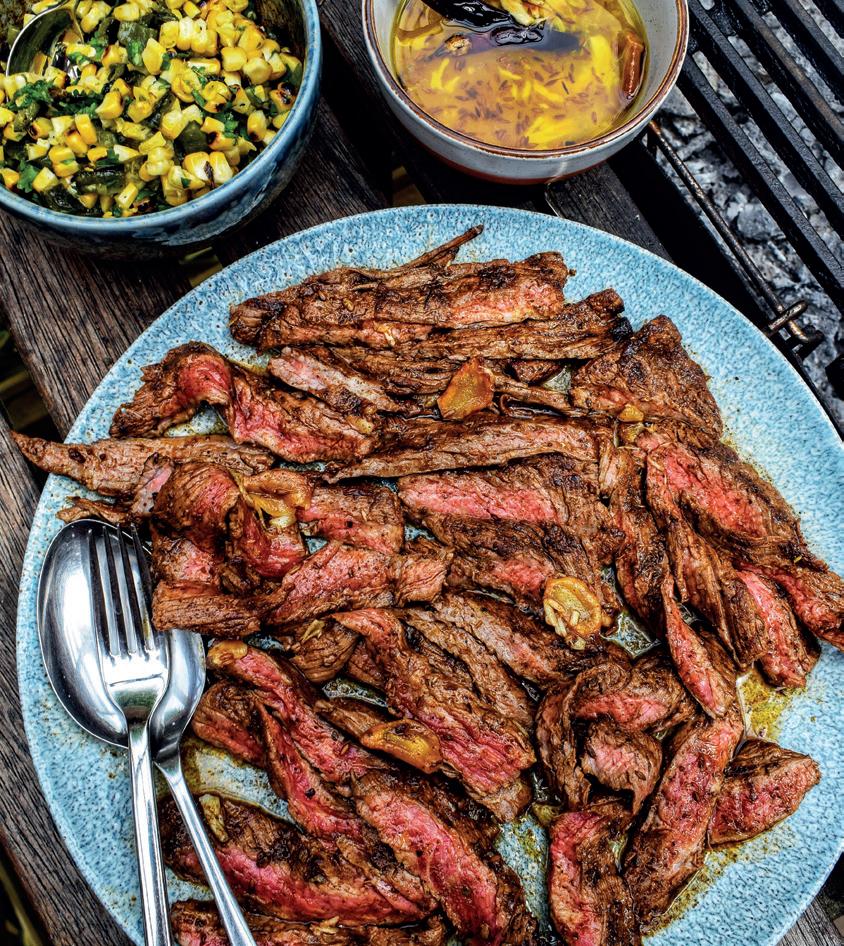


Britain is home to millions of people whose culinary heritage is steeped in a rich tradition of cooking over fire. However, it’s also home to millions of people who were brought up thinking that a barbecue begins and ends with sausages in soft buns and a pile of questionably pink-tinged chicken legs. Thankfully, those streams are now crossing. Awareness is growing that cooking over fire isn’t just for bangers and burgers but for spiced meats, spatchcocked birds, whole fish and even (no, really) vegetables.
Fire and smoke can greatly elevate the natural flavours and textures of fresh produce. That’s the magic of a barbecue. But – more so than many other forms of cooking – you really do get back what you put in. So shop at Borough Market with quality and seasonality front of mind, then get the fire started.
Explore more recipes
Eight simple steps towards the perfect Borough Market barbecue
Mark Riddaway
1
Go low and slow. There are few things more packed with flavour than the large, sinewy, hardworking muscle of a free-range animal, cooked into melty submission in the gentle heat and subtle smoke of an oil drum or kamado-style barbecue over many hours. Head to Northfield Farm or Ginger Pig for high-welfare brisket, Jacob’s ladder, beef featherblade, pork shoulder, pork collar, lamb shoulder and other such beautiful, burly proteins.
2 3
Flatten your chicken. Cook whole birds on the barbecue after having them skilfully spatchcocked by Wyndham House Poultry or one of the other Borough Market butchers. This involves removing the backbone and flattening the chicken (or other poultry), allowing it to cook more quickly while ensuring the fattier parts keep the breast from drying out.
Land some sardines. Call them ‘pilchards’, as was previously the case, and they don’t sound particularly appealing. Call them ‘sardines’, as is far more likely these days, and they’re suddenly imbued
4
with Mediterranean glamour. Either way, they’re great on a barbecue: juicy and tender, with crispy skin and deeply flavoursome flesh. Wildcaught sardines landed by certified fleets in the English Channel and the Celtic Seas around the West Country are a highly sustainable option, and their appearance in our waters is perfectly timed for barbecue season. Head to Furness Fish Markets or Shellseekers Fish & Game to land your catch.
Embrace the aubergine. The aubergine is the ultimate barbecue vegetable, forgiving of intense heat, easily enhanced by a lick of smoke, and at its best when ripened in southern European summer sunshine. Slice lengthways, crosshatch, drizzle with fats and flavourings, then grill until tender and striped. Or else blacken the skin to the point of collapse and spoon out the creamy flesh to make baba ganoush. You can do the latter directly on the coals – it’s always worth slinging a couple of aubergines into the diminishing heat of the barbecue once you’ve finished your main cook.

6
Spice it up. Cooking over fire is central to the cuisines of vast swathes of the world, reflected in the wide array of barbecue-friendly spice rubs and seasonings sold by our traders. Among many others, enjoy Pimento Hill’s Jamaican jerk seasoning, Arabica’s Levantine za’atar and ras el hanout, and Spice Mountain’s Korean barbecue blend, Japanese teriyaki, Tunisian tabil and Ethiopian berbere.
7
Bring the heat. A good chilli sauce is an essential barbecue condiment. Doreen at De La Grenade imports hers from the Caribbean island of Grenada, including the helpfully named Hot Pepper Sauce and Very Hot Pepper Sauce. Wiltshire Chilli Farm provides a wide range of outstanding sauces from the less tropical environs of Melksham.
Choose your charcoal. If you’re buying sustainable meat, fish and veg from Borough Market’s traders, apply the same level of consideration to your charcoal. In some parts of the world, its production is a major cause of deforestation, making it vitally important we understand the provenence of our coals. Chef and barbecue expert James Whetlor says: “We need to support a sustainable charcoal movement in the UK. If you’re a good charcoal maker, your job isn’t making charcoal, your job is managing forest. Find someone who is looking after a portion of woodland and making charcoal as a byproduct. Buy from them.” 5
Grab some fats. Olive oil, abundant at Borough Market, is great for cooking veg, dressing just about everything, and binding herbs and spices to their target. But a trip to the Hook & Son dairy stand might also be in order. In our cookbook, Borough Market: The Knowledge, James Walters of Arabica explains: “When it comes to barbecue marinades, I sometimes use yoghurt or buttermilk rather than oil. They keep the meat really tender and help lock in those smoky flavours. If you have too much oil in the marinade it will flare up when the flames start kissing the meat, and the meat will end up tasting slightly acrid, like carbon.”
8
Nick Willoughby, founder of The Black Pig, on his favourite fire-cooked dish
Interview: Mark Riddaway
Nick Willoughby is the founder of The Black Pig, which sells its world-famous sandwiches in the Borough Market Kitchen. For these, slow-roasted pork is finished in the heat and smoke of a kamado barbecue before being piled generously into pillowy toasted ciabattas. Nick, a fire-cooking obsessive, talked to us about the dish he most enjoys creating in his own back garden: “I’m passionate about Cajun and Creole cooking,” he says, “and my favourite dish to cook on the barbecue is a jambalaya.”
The dish
I sear all the main elements on the grill first –the andouille sausage (the American version, not the classic French one), the chicken, the shrimp – not to cook them all the way through, but to give them some real colour and flavour from the coals. In a paella pan on the barbecue, I cook down the Cajun ‘holy trinity’ of celery, green pepper and onion with some tomato paste, Cajun seasoning and Old Bay spice blend, then throw in long grain rice and chicken stock. Once that’s bubbling away, I add in the seared meat and seafood. For this to work, you need a barbecue with a lid that can close. Chuck in a few woodchips to create a bit more smoke, then leave it to cook through slowly. It smells amazing, tastes amazing, and you get these lovely gnarly caramelised bits around the sides. Stick it in the middle of the table and let everyone help themselves.
I used to live in the United States. I was an aspiring golf pro at the time, so I did a lot of travelling. I fell in love with New Orleans – I’ve been there many, many times. I love that it’s this melting pot of people and cultures. You’ve got that French influence, but also Spanish and Caribbean. That’s reflected in the food: you’ve got these amazing recipes that use traditional French cooking techniques but are packed full of spice and flavour.
The quality of ingredients is essential. I like to know that my food has been produced in the right way, with care and attention, which also results in better flavour. At The Black Pig, we use free-range Blythburgh pork – when you slow-cook it, it retains its structure and flavour, whereas mass-produced pork goes to mush and tastes of almost nothing. When I’m at home, it’s the same principle. If I’m going to use prawns in my jambalaya, I want prawns that taste like they’ve come from the sea. I want chicken with real depth. Borough is where I come to do my shopping – and I’m not just saying that because I’m a trader. I love coming early in the morning at the weekend. I bring the kids down. We go to the fish stands and to Spice Mountain, which is just amazing. If I’m trying to cook something interesting, it has everything I need.
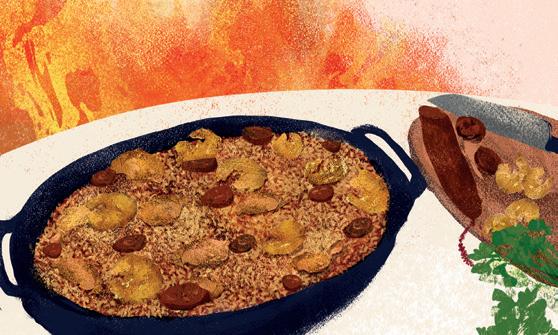
YOU CAN DRAW SO MUCH HEAT FROM A BARBECUE, SO YOU CAN GET THAT LOVELY CARAMELISATION, BUT WITH ALL THAT EXTRA FLAVOUR THAT YOU COULD NEVER GET ON A HOB.
own and I’ve got lots of time, I love cooking with logs, but next best thing is lumpwood charcoal. It’s basically big old chunks of burnt wood, whereas the stuff you get from a petrol station is like dust in a bag. A few woodchips in with the coals can be good too. At The Black Pig we throw in some apple woodchips, and that gives our pork a blast of extra smoke when we finish it on the barbecue.
The method
People in Britain rarely use pans on a barbecue, but it’s such a great thing to do. It really struck me when I went on holiday to Carriacou, a little island off Grenada. We were at this beach barbecue where a guy was cooking fish with a simple tomato and red pepper sauce. He had the sauce on a pan on the barbecue, and because of the smoke slowly seeping in, the flavour packed into it was unbelievable. You can draw so much heat from a barbecue, so you can get that lovely caramelisation, but with all that extra flavour that you could never get on a hob.
The fuel
Fuel is really important. If I’m cooking on my
I barbecue throughout the year, probably two or three times a week. I love the flavour and I love how involved it is. I hate baking, I can’t deal with fixed parameters, but with a barbecue you’re really connected to what you’re doing. It creates atmosphere, it draws everyone outside, it’s social. I like doing food for the table for people to share, creating that environment where everyone’s sitting together, chatting.
Control the temperature. A lot of people get their barbecue super-hot and just use it to blister sausages, but it can be so much more versatile than that. Just think about what it is you’re cooking and set the heat accordingly. If you’re cooking a steak indoors, you’ll get the frying pan really hot. But if you’re roasting a chicken in your oven, you don’t do it at 300C, so for chicken just put a few coals in and get it to about 160C.
Ed Smith
Serves: 6-8 as a side | Prep: 10 mins | Cook: 5 mins
Courgettes are a great vegetable to barbecue, especially when grilled briefly so they are browned on the outside yet remain relatively raw and crunchy within. In the summer, you’ll find mounds of them at the Market, of all different shapes and sizes: straight, dark greens and yellows, of course, but also pale and speckled varieties, spherical, and long and bendy ones. This charred, herby salad, dressed with mellowed and jammy burnt lemons, shows how you can use a barbecue to cook and assemble exciting platters of seasonal food. Bolster it with ricotta, feta or fresh goat’s cheese to turn it into a more substantial dish. Try the same method with summer squash (patty pans) which you might stumble upon in August and September. If the weather’s inclement, you can also prepare this using a griddle pan.
— 1.2kg courgettes (different shapes and colours), cut into 2-3cm-thick triangular wedges
— 1 lemon
— 1 mild red chilli, finely diced
— 4 sprigs of mint, leaves picked and shredded
— 20-30 basil leaves
— 4 tbsp extra virgin olive oil
— 2 tbsp za’atar
Toss the courgette pieces in 1-2 tbsp sunflower or vegetable oil. Thread the courgette pieces onto skewers (to avoid losing too many through the grill), ensuring the cut faces will be exposed to the heat, rather than the edges with skin.
Lay over a hot barbecue and allow to blister and brown. If the courgettes have not softened too much (they should retain some bite), turn the skewers and colour them on another side, too. At the same time, cut the lemon in half and place the halves cut side down on the barbecue for a few minutes, leaving them to colour, soften and become sticky.
Transfer the cooked courgettes to a bowl or tray. Squeeze the jammy lemon juice over and add lots of flaky sea salt, black pepper, the diced chilli, three quarters of the fresh herbs and all the extra virgin olive oil.
Toss and leave for the flavours to mingle for 3-5 minutes, then tip onto a serving platter where the courgette pieces can be spread out.
Add the remaining fresh herbs and sprinkle the za’atar liberally over the salad.
Recipe from The Borough Market Cookbook by Ed Smith (Hodder & Stoughton)

Serves: 2 as a main, 4 as a side | Prep: 5 mins | Cook: 30 mins
This is the dish that will make you fall in love with aubergines, highlighting their versatility and ability to absorb rich flavours. When grilled, the aubergines develop a tender, creamy texture with a slightly smoky char, enhancing their natural taste. The addition of sweet chilli sauce creates a sticky contrast, giving the dish a jammy coating that complements the aubergines perfectly. Tahini adds a nutty, creamy element, while fresh mint leaves provide a burst of herbal notes. Pine nuts and pomegranate seeds add crunch and sprinkles of sweetness, making this a mouthwatering dish!
— 2 big aubergines
— 4 tbsp sweet chilli sauce
— 4-5 tbsp tahini
— A handful of fresh mint leaves
— A handful of pine nuts
— A handful of pomegranate seeds
Heat either your barbecue or the grill of your oven. If using an oven grill, line a baking tray with parchment paper.
Drizzle the whole aubergines with olive oil and sprinkle with salt. Grill the aubergines for 20 mins, turning occasionally, until tender and slightly charred.
Cut the aubergines in half lengthways and spread a generous amount of sweet chilli sauce over the flesh of each half. Return them to the barbecue or grill and cook for an additional 10 mins, until the sweet chilli sauce becomes sticky and jammy.
Transfer the aubergines to a serving dish. Drizzle with tahini and sprinkle with fresh mint leaves, pine nuts and pomegranate seeds. Serve immediately.
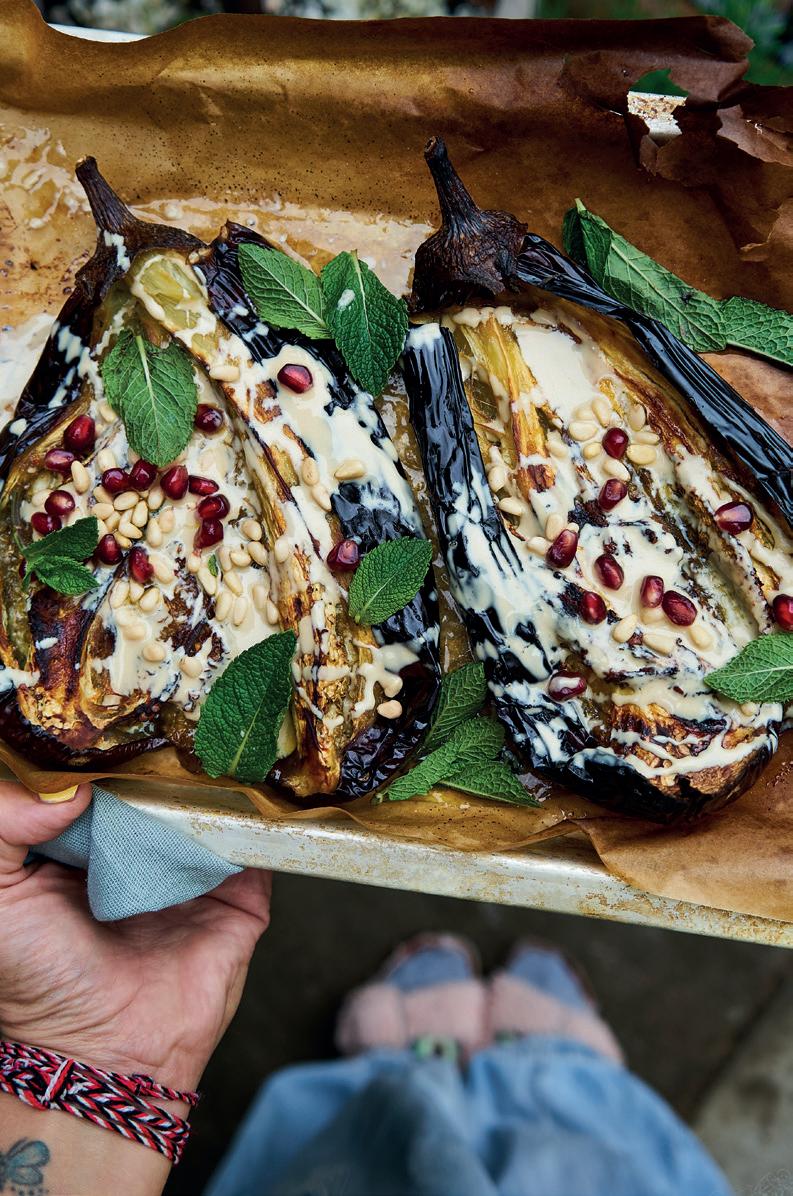
Serves: 4| Prep: 10 mins | Cook: 5 mins
— 4 little gem lettuces, cut in half lengthways
— 150g plain yoghurt
— 2 cloves of garlic, crushed
— 1 tsp cumin seeds, lightly crushed
— 1 lemon, cut into wedges
— 50g pistachios, lightly toasted
— 1 tbsp za’atar
— 1 x 400g can of chickpeas, rinsed and patted dry
— A small handful of chopped oregano
Heat the barbecue to a medium heat. Toss the lettuces with 1 tbsp olive oil and a pinch of salt. Place on the heat and grill, cutside down, for 3 mins, then turn and cook for a couple more minutes on the other side until nicely charred all over.
Place the yoghurt in a bowl and mix with the garlic, cumin, the juice of ½ lemon and a pinch of salt.
Spread the yoghurt over a platter, drizzle with 2 tbsp olive oil and scatter over the nuts and za’atar.
Toss the grilled lettuce with the chickpeas in a bowl. Arrange the mix on the yoghurt, nuts and za’atar and serve with a squeeze of lemon and the chopped oregano.
Recipe from The DIY BBQ Cookbook by James Whetlor (Quadrille)

Cynthia Shanmugalingam, chef-owner of Rambutan, on her favourite fire-cooked dish
Interview: Mark Riddaway
Cynthia Shanmugalingam is the chef-owner of the acclaimed Rambutan restaurant and the author of a best-selling cookbook of the same name. Born and raised in England but with roots in Sri Lanka, Cynthia finds inspiration in the vibrant food culture of her ancestral home but views it through the unique lens of her British upbringing and global travels. At the heart of her Borough restaurant is a large charcoal grill. “There’s something magical about walking into a space where a fire is going,” she says, “and it’s fun for the chefs, who love learning how to deal with fire.” Her current favourite of the many dishes cooked over those hot coals is pork neck in a bright, peppery marinade, served with a sharp chilli sambal on the side.
dish
Pork neck is a lovely, forgiving cut of meat to cook over charcoal. We marinate it in lots of Sri Lankan black pepper, which is the real star of the show – super-fragrant, almost floral. There’s also some cumin, some ginger and garlic and a little bit of kithul jaggery syrup to give it a touch of sweetness (although you could use maple syrup instead). We grill the pork then serve it with a pickled chilli sambal, which is basically green chillies, vinegar and sugar: hot and sharp, to cut through the pork.
Sri Lankans don’t actually have a big tradition of grilling. Fire cooking is fundamental to Sri Lankan cuisine, but they tend to build a fire and then cook curries in clay pots over the flames. Rambutan is not a super-traditional Sri Lankan restaurant, though. I was born in England, grew up here and travelled around a lot, all over the world, so this place is a mix of all my influences. I wanted to have a charcoal grill front and centre, but grilling Sri Lankan food requires a little bit of adaptation. We might, for example, take a traditional curry recipe and then recreate the flavours through a marinade or a dry rub. This pork dish was invented by one of our young chefs, Jack, who was inspired by black pepper beef, a classic Sri Lankan curry from the west of the country.
The pork in Sri Lanka is fantastic quality –there are all these small, dense pigs that run around all the time and are just so flavourful. Over here, we’re looking for that same depth of flavour, and that can only come from animals that have got space to roam and are fed and reared amazingly well. We use Middle White pork from Swaledale in Yorkshire. The taste of the meat is so deep, it’s almost gamey. The quality of the black pepper is also essential. It’s known as Malabar pepper, produced down the Malabar

FIRE IS MAGICAL, FIRE IS MESMERISING. COOKING OVER FIRE IS A WHOLE PROCESS – IT’S NOT LIKE SWITCHING ON AN OVEN – AND I THINK THAT’S PARTLY WHAT MAKES IT SO EXCITING.
chemicals. It gets good and hot and retains its heat very well. I feel that if there’s anything chemical in the charcoal, you can really taste it, so we only use the best quality charcoal we can get our hands on.
coast of southern India and into Sri Lanka. It’s so good that wars have been fought over it! ‘Black gold’, they used to call it. It’s really floral. Bright and fragrant. Almost citrussy.
We grill the pork over the hottest part of the charcoal, so it doesn’t take long – a few minutes each side. We cook it to an internal temperature of 45C, then let it rest for about five minutes. It’s at its best when it’s still slightly blush inside, as long as the guests are okay with that.
The fuel
We use pure lumpwood charcoal with no
Fire is magical, fire is mesmerising. Cooking over fire is a whole process – it’s not like switching on an oven – and I think that’s partly what makes it so exciting. In Sri Lanka, most cooking is done over wood, so you have to build the fire first – the big sticks, the little ones, the paper – and that makes it so involving. It also imparts the amazing aromas and flavours of the smoke. In Sri Lanka, try as the government might to bring in gas or electricity, the women – and it is largely women who do the cooking – still want to cook over wood. They just feel there’s nothing quite like those incredible smoky flavours.
People should grill more vegetables! We put lots of veg on our grill – the sugars caramelise, and they take on such an amazing quality. Aubergine, corn, broccoli, anything. Often, if you go to someone’s house for a barbecue, it’ll be the meat that gets the focus, but vegetables can be just as delicious.
For the ancho hanger steak
— 250g hanger steak, butterflied
— 1 tsp ancho chilli powder
— ½ tsp ground cumin
— ½ tsp smoked paprika
— ½ tsp Mexican oregano
— A good pinch of sea salt
— 2 tbsp light oil
For the mojo de ajo
— 3 arbol chilies
— 20 cloves of garlic, peeled
— 1 tsp cumin seeds
— 100ml extra virgin olive oil
— 1 orange, zest and juice
For the charred corn and jalapeno salsa
— 1 whole golden corn cob
— 4 green jalapenos
— 1 clove of garlic, peeled and minced
— 1 lime, zest and juice
— 2 tbsp extra virgin olive oil
— A handful of coriander, roughly chopped
— A good pinch of sea salt
To butterfly the steak, make a horizontal cut most of the way along the side of the steak, stopping before you get to the end so that it opens up to reveal two matching sides. The steak is now thinner and more tender and will cook quickly without burning the marinade.
In a small bowl, combine the chilli powder, cumin, paprika, oregano and sea salt with the olive oil. Rub the paste on both sides of the steak and leave to marinate for at least 1 hour.
To make the mojo de ajo, heat a cast iron or heavy based pan on a low-medium heat. Toast the arbol chillies, garlic cloves and cumin seeds for a few seconds, releasing their flavour, before pouring in the olive oil. Bring to a gentle simmer and, using a spoon, continue to confit the garlic until lightly brown and soft to the touch. Remove from the heat, add the orange juice, zest and sea salt and transfer to a small serving bowl.
Bring your barbecue up to a fierce but steady heat with white coals. Place the whole corn cob and jalapeños directly onto the grill, turning occasionally until evenly charred all over. Remove to a chopping board and allow to cool slightly while you grill your steak.
Ensure the barbecue is still fiercely hot. Using tongs, place the steak directly onto the hot grill and flip every 30 seconds so the flames lick the meat. After a few minutes, when the steak achieves a good dark-golden crust, remove from the barbecue, place on a carving board, and spoon over half of the mojo de ajo. Leave to rest for a few minutes while you finish preparing the salsa.
Hold the charred corn upright on the board and run a knife downwards to shave the kernels from the cob. Transfer to a mixing bowl. Finely chop the charred jalapeños and add to the bowl, along with the minced garlic, lime juice and zest, chopped coriander, sea salt and olive oil. Mix well and set aside.
Thinly slice the steak, mixing it up in its resting juices as you do. Spoon over the salsa and serve alongside the remaining mojo de ajo. Serve with warm corn tortillas and a fiery hot sauce.
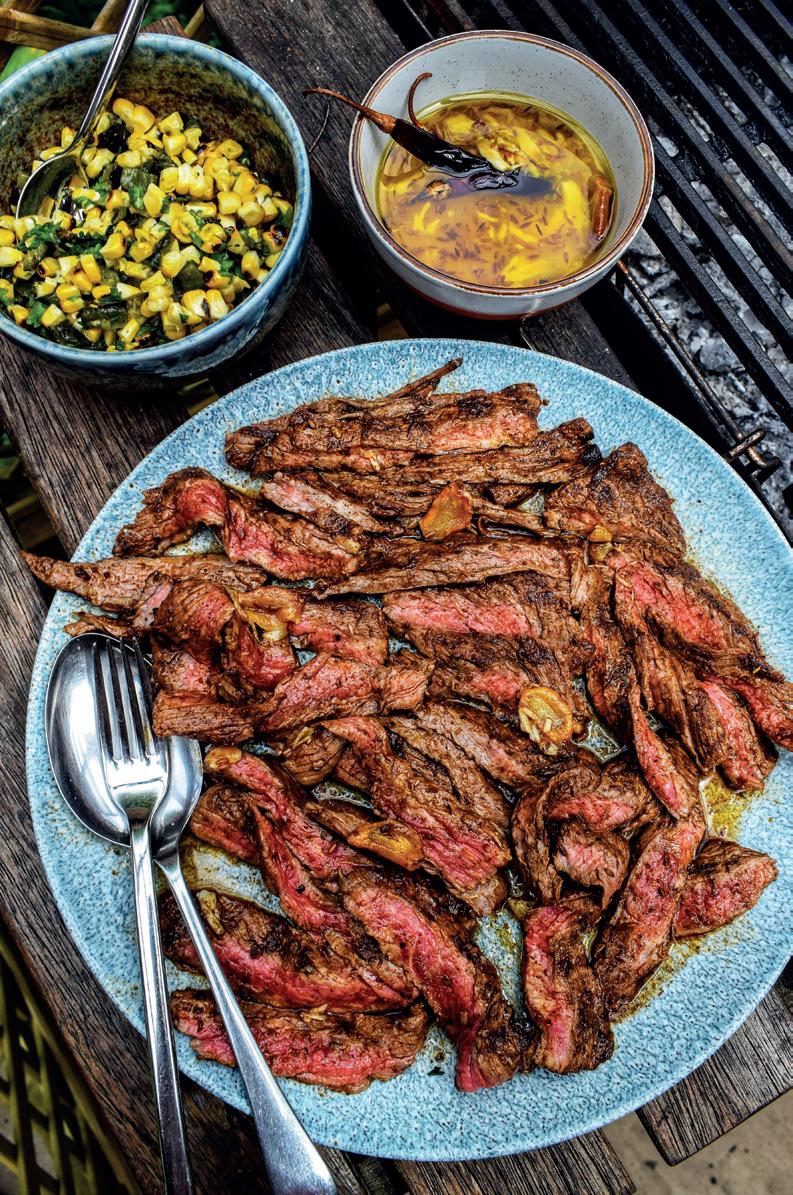
Serves: 4 | Prep: 10 mins | Cook: 45 mins
For this recipe, I decided to buy a really good bird, season it up with paprika, pul biber (Aleppo pepper) and garlic and get it on the grill. I got a Label Anglais chicken from Wyndham House Poultry and asked them to spatchcock it for me. I got some beautiful tomatoes and dressed them in yoghurt, garlic and olive oil. I served it all up family-style.
For the chicken
— 1 spatchcocked chicken
— 2 tbsp Aleppo pepper flakes
— 2 tbsp paprika
— 4 cloves of garlic, crushed — 100ml vegetable oil
For the tomato yoghurt
— 4 tbsp yoghurt
— 1 clove of garlic, crushed
— ¼ tsp cumin seeds, toasted and crushed
— 2 tomatoes
— Juice of ½ lemon
For the dressed herbs
— 6 stalks of coriander
— 6 stalks of parsley
— 6 stalks of mint
— 1 tbsp pomegranate molasses
— Juice of half a lemon
Pat the chicken dry with a cloth – this helps the marinade do its job. Add all the ingredients to the chicken and give it a good massage with your hands. Let the chicken marinate for at least a couple hours but ideally overnight.
You can roast the chicken in the oven but for me the best results are always over the fire. Light the barbecue and let the coals run white hot. You should be able to hold your hand about 20cm above the coals and count to four.
Push a couple of skewers all the way through the bird to help you lift it, then place it in the middle of your barbecue grill. Keep turning it every 2-3 mins – this is key, as you want to create natural smoke from the dripping chicken fats but not cook it on one side long enough to burn.
Grill the chicken for about 45 mins, then let it rest for at least 15 mins. I like to rest my chicken on top of the flatbreads I’m serving with it – it’s a shame to let those juices go to waste.
Mix the yoghurt, garlic and cumin seeds in a bowl. Roughly chop the tomatoes into bitesized chunks – it doesn’t have to be uniform. Season the tomatoes with sea salt then mix into the yoghurt – the salt releases tomato juice, which helps to loosen it all up. Finish with a little more olive oil and some more crushed cumin
Stick all the herbs in a large bowl of iced water for about 10 mins. This brings the herbs back to life and makes them crispy. Dry off the herbs and place them in a bowl. Season with salt, pomegranate molasses and lemon juice.
I like to serve this all together on the same plate and let people eat it how they want to, whether that’s wrapped in a flatbread, with their hands straight off the bone, or from a plate with a knife and fork.
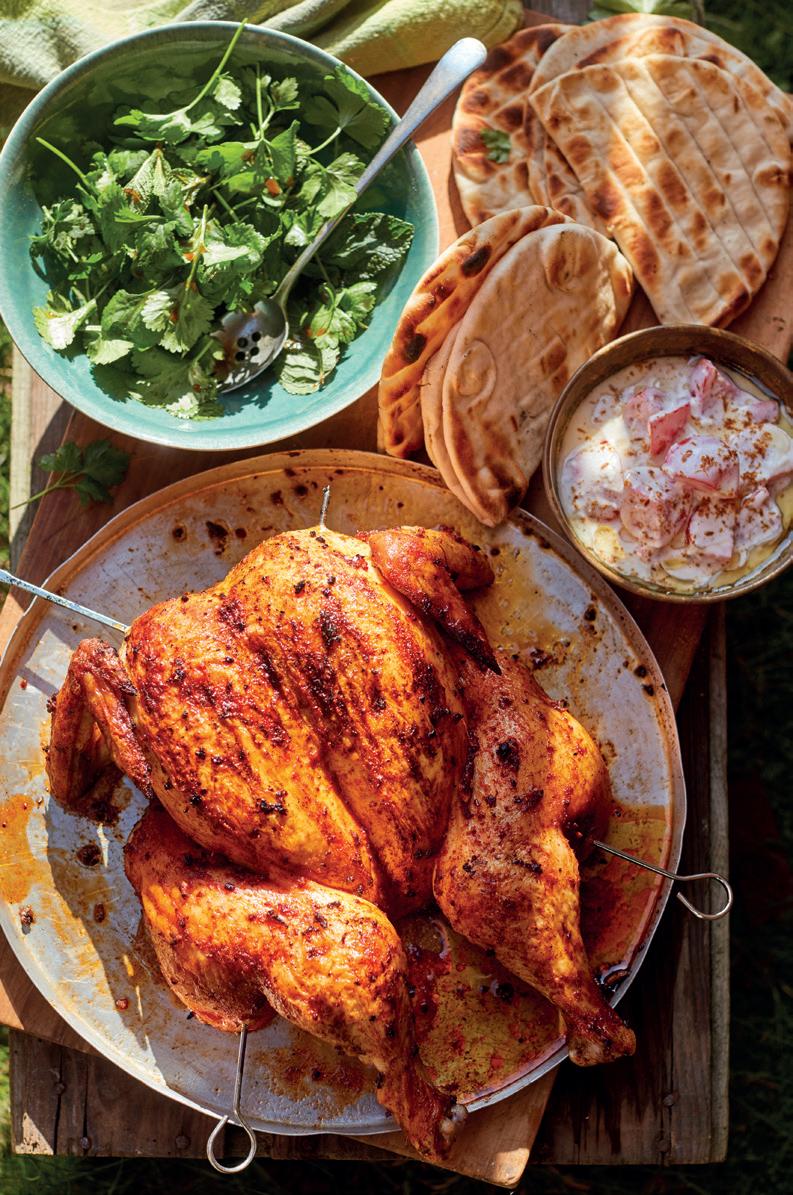
Spatchcocked chicken Wyndham House Poultry
6-8 | Prep: 20 mins + resting | Cook: 4 hours
For the pork
— 4kg piece of pork belly, loin attached (ask your butcher for one in advance), without bones
— 1 bunch of parsley, finely chopped
— 1 bunch of thyme, thick stalks removed, leaves finely chopped
— 25 sage leaves, finely chopped
— 8 sticks of rosemary, leaves finely chopped
— Zest of 2 lemons (keep the juice for later)
— 1½ tbsp Sicilian lemon salt
— 2 tbsp pink peppercorns, finely crushed
For the sauce
— ½ shallot, finely diced
— 2 plum tomatoes, deseeded and diced
— 10g parsley leaves, finely chopped
— 10g coriander leaves, finely chopped
— Juice of the 2 zested lemons
— 1 clove of garlic, crushed
— 1 tsp smoked paprika
— 3 tbsp cider vinegar
— 3 tbsp rapeseed or olive oil
— A pinch of sea salt
For the pork, mix the chopped herbs with the shallot, lemon zest and pink peppercorns. Cut five pieces of butcher’s string to the length of the pork belly and lay out on a board.
Using the tip of a really sharp knife, poke the skin all over, piercing the skin but not going so deep that the blade goes into the flesh. (Alternatively, you could ask the butcher to score the skin for you.)
Lay the pork belly on top of the strings, skinside down. Sprinkle the pork with the Sicilian lemon salt, then spread the herb mix on top, leaving a 3cm gap around the edges. Roll the pork belly up from the loin end, tucking the loin in tight then rolling it into the rest of the pork belly. Tie the middle string first to hold everything in place. Tie up the end knots, then the remaining ones. Scoop up any herb mix that’s fallen out and push it back into the gaps.
Sprinkle salt onto the skin of the pork belly. Leave the pork in the fridge, uncovered, for a minimum of 3 hours or ideally overnight.
Light the barbecue, then move the coals into two piles on either side of the grate, leaving the centre clear. Put a pan between the two piles to catch the dripping fat, then place your grill above. After rubbing the skin with a cloth to dry it off, place the rolled pork in the middle of the grill, away from the direct heat. Close the barbecue lid, and half open the vents. Cook for 3 hours, checking every 45 mins and topping up the charcoal as needed.
Meanwhile, mix all the sauce ingredients together and set aside. After 3 hours cooking, open the top and bottom barbecue vents fully to bring the temperature up. Make sure there’s enough charcoal and top up as necessary. Roast at a high temperature for 30-40 mins until the crackling is bubbled and crispy.
Remove the pork belly from the barbecue and rest for 20 mins in a tray to catch the juices. Slice and serve with the sauce and whatever sides you like.
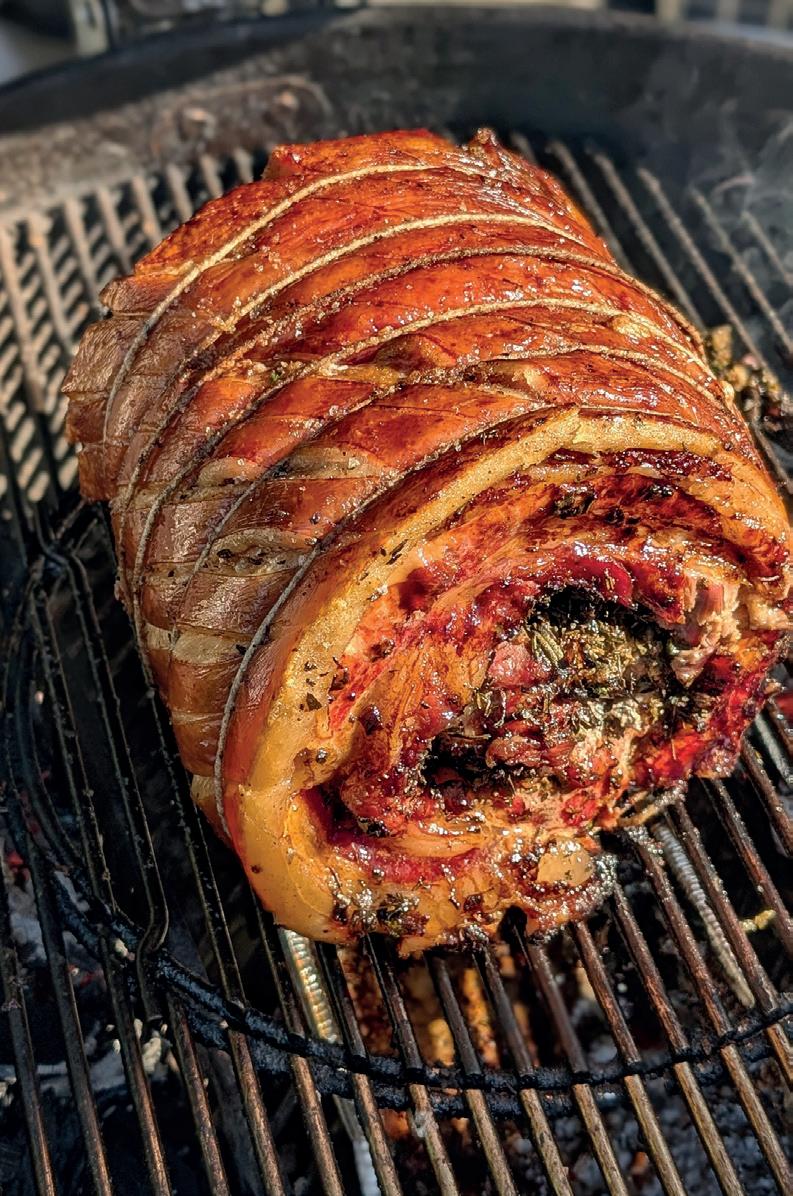
Ursula Ferrigno
Serves: 6-8 | Prep: 10 mins + marinating| Cook: 10 mins
— 6 cannons of lamb (eye of the loin), trimmed of fat, around 140g each
— 150g firm ricotta, ewe’s milk if possible, coarsely crumbled
— 8 firm, fruity tomatoes, mixed shapes and colours, cut into wedges
— 150g cherry tomatoes on the vine, halved
For the marinade
— 2 tbsp fresh oregano, finely chopped (plus extra to serve)
— 1 unwaxed lemon, juice and zest
— 2 cloves of garlic, thinly sliced
— 60ml extra virgin olive oil
— 1 tbsp red wine vinegar
For the onion pickle
— 4 red onions, cut into thick rounds
— 3 tbsp olive oil
— 1 clove of garlic, finely chopped
— 2 tbsp thick, luscious balsamic vinegar
METHOD
Place the lamb in a ceramic dish and marinade with oregano, lemon juice and rind, garlic, oil, red wine vinegar and a sprinkle of salt and pepper. Allow to stand and turn in the marinade several times.
To make the pickle, bring the barbecue to a medium heat, lightly brush the onion with oil and grill for around 3 mins, until lightly browned. Transfer to a bowl and add the remaining ingredients. Season and set aside.
Remove the lamb from the marinade, then barbecue for 6-12 mins until cooked to your liking, turning once. Rest for 5 mins.
Carve the lamb, place on plates scattered with the ricotta and tomatoes, some extra oregano, oil and vinegar. Serve topped with onion pickle.
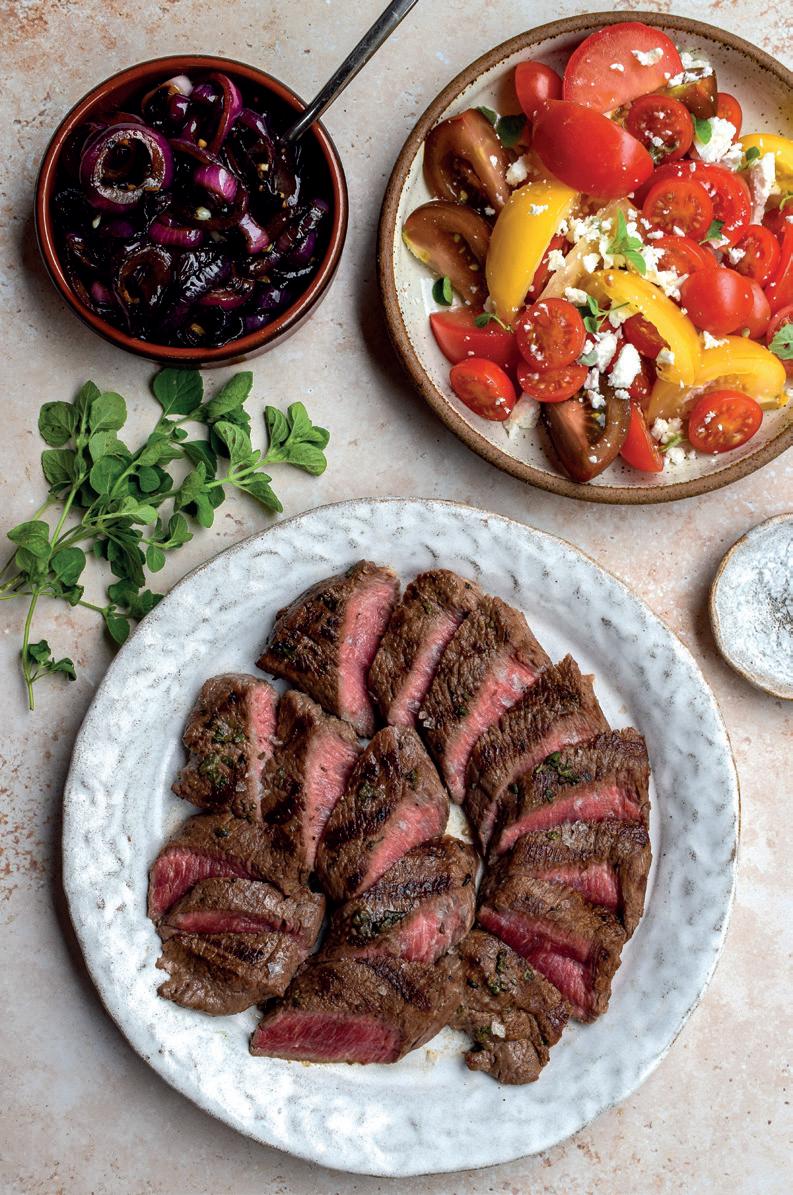
David Carter, the restaurateur behind OMA and AGORA, on his favourite fire-cooked dish
Interview: Mark Riddaway
David Carter is the restaurateur behind Borough’s OMA and AGORA. At OMA, one of the many skilfully executed, Greek-inspired small plates on offer is a squid skewer dressed in a simple olive oil marinade. In common with his other London restaurants, OMA and AGORA both have a significant fire-cooking slant to their menus. It’s only natural. David was born and raised in Barbados, where cooking over wood or charcoal is central to the island’s cuisine, social scene, family life – everything, really. “Every day is 27, 28 degrees, so it’s just part of the culture,” he says. “What could be nicer?”
The dish
This is a very simple dish. We cut off the head and wings of the squid and just use the body. We score it quite heavily, which means that when we grill it we get this amazing texture – squid can be quite chewy if you’re not careful. We brush it with olive oil that we’ve infused with confit garlic, za’atar and lemon juice. The confit garlic is almost a bit pasty in texture, in a good way, and that really adds to the feel of the dish. We then grill it over charcoal and serve it straight away.
This dish was inspired by a restaurant in Athens called Travolta. OMA and AGORA are both rooted in Greece, but in a broad way. Not
all the flavours are Greek, like the za’atar we use here. We did a lot of travelling when we were working on the concept, including to Tel Aviv, and that’s where the idea of adding za’atar came from. We can get squid through most of the year, but I think this really lends itself to being a summer dish – it has that lightness. I’d maybe have it with something tomatobased, with high acidity. A Greek salad, maybe. Light, vibrant dishes and zippy wines.
With so few ingredients, there’s nowhere to hide. Everything has to be good. The squid comes from the southwest of the country. It’s an amazing product. Most of the fish and seafood we use comes from Cornwall, from Brixham market. It’s caught and landed one day, it comes to us overnight, and the next day it’s in our kitchen. One of the great things about being such a busy restaurant is that whatever comes in goes pretty fast –it arrives and we cook it. The olive oil comes from a regenerative farm in Crete, run by two brothers. They’re actually British – one of them married a local girl. They moved out there to Zakros and started this incredible olive oil project. We’re now using it across all our sites.
The trick is to have the grill hot, but not too hot. You don’t want to blacken the squid;

angry, and all that flavour is released into the air. You can’t get those flavours on a stove.
THERE’S SOMETHING PRIMAL ABOUT FIRE, SOMETHING COMFORTING. I’VE GOT A FIREPLACE AT HOME, AND WHEN IT’S FREEZING OUTSIDE I WOULD RATHER LIGHT A FIRE THAN PUT A RADIATOR ON.
The appeal
you want it to be a deep dark brown. It takes about 6 minutes, so not long. With squid, or with almost any fish, you want to pull it off the grill when it’s a little under. Because of the residual heat, it’s still cooking when it gets to the table. If you overcook it, it becomes chewy and rubbery, which is horrible.
We use very pure charcoal. With grilling, it’s about the fuel, but it’s also about the interplay with the fat – that’s what creates the flavour. When the oil from the squid drips onto the coals it creates smoke, which then permeates the food above. That’s what grilling is all about – when fat renders onto hot coals, and the coals get a bit
I grew up in Barbados. I grew up outdoors. There, every day is a barbecue – it’s just part of the culture, so cooking over fire is what I’m most comfortable with, for sure. There are so many variables, with the fuel and the heat, and that’s what makes it interesting. It’s such a versatile and simple way of cooking – all you need is some charcoal on a beach and you have a barbecue. There’s something primitive and primal about it, something comforting, warming. I’ve got a fireplace at home, and when it’s freezing outside I would rather light a fire than put a radiator on.
The pro tip
Have fun with it. Some people take barbecuing far too seriously. It should be social and fun, and if you don’t cook something perfectly, who cares? Also, be patient. When you light it, let it burn out properly. When it’s flaming, that doesn’t mean it’s necessarily lit – with bad charcoal, it’s the chemicals that are burning, and if you cook too early your food will just taste of lighter fuel. Let it come to temperature, let it do its thing. Wait until it’s glowing red or white, and don’t be frightened to move it around. If it’s too hot, disperse it; if it’s not hot enough, bring it together. Play with it. The fire is your friend!
Serves: 2 | Prep: 15 mins | Cook: 7 mins
— 1 tsp fennel seeds
— 5-6 sorrel leaves
— 100g creme fraiche
— 2 golden beetroots
— 1 fennel bulb
— 1 pink grapefruit
— 500g red mullet, filleted
— A knob of butter
METHOD
Start by making the dressing. Warm a small pan and add the fennel seeds. Heat until they start to jump around, then crush them a little in a pestle and mortar to release the oils.
Make a chiffonade of the sorrel: stack the leaves neatly on top of each other and roll them up lengthways, very tightly. Slice across the roll as thinly as you can, making delicate strips. Use an extremely sharp knife so as not to bruise the leaves.
Mix together the creme fraiche, sorrel and half the toasted seeds, along with 50ml water, then season well. Set aside.
Peel the beetroots and slice very thinly. Use a mandolin if you’re feeling brave or a very sharp knife if not. Place in a large bowl.
Trim the fronds from the fennel and set aside. Slice the bulb in half lengthways, cutting out the core if it seems a little tough. Cut across the fennel very thinly to make pretty little semi-circles. Add to the beetroot.
Segment the grapefruit by firstly paring away
the thick skin and pith. Hold the fruit over the bowl containing the beetroot and fennel, and cut in between the pithy membranes, allowing the beautiful segments to escape into the bowl below. Squeeze out the leftbehind pith. Toss in the fennel fronds and remaining toasted fennel seeds and set aside while you cook the mullet.
Rub a little oil on each fillet, season generously, then sprinkle with the remaining fennel seeds. Get the barbecue good and hot. Place the mullet on the grill skin-side down and cook for around 4 mins, resisting the temptation to fiddle with it while it cooks. Turn, then grill for a further 3 mins.
Serve the fish on piles of salad, with a dollop of the flavoured creme fraiche.

This is a dish for which you can get everything ready in advance, leaving just the charring of the octopus on the barbecue until the last minute – a real show stopper. It would also work wonderfully well with squid or cuttlefish, which will take just seconds to cook from raw. Simply sear the translucent tubes and tentacles until they turn opaque.
— 1-1.5kg cleaned octopus
— 1-2 red chillies, sliced in half
— 4 cloves of garlic, whole but crushed
— 1 large bunch of flat leaf parsley
— ½ tsp salt
— 150ml extra virgin olive oil
— 1 x 660g jar of butter beans, drained
— 6 roasted piquillo peppers (about 100g), sliced
— 2 lemons, cut into segments
Freezing the octopus will help tenderise the flesh, but be sure that it is completely thawed before cooking. Cut the tentacles off just below the eyes and then cut the head away from just above. Throw away the eye section and push your little finger through the centre of the tentacles to remove the little thorn-like beak.
Take a small saucepan and pack in the octopus’ head and tentacles with the chillies, garlic, parsley stalks (keeping the leaves for the salad), salt and the olive oil. The octopus should be almost covered by oil. Cover and place the pan on a really gentle heat, just a low simmer, for anything between 30 mins and 1 hour, until the flesh is tender when prodded with a fork.
Meanwhile, pour the beans onto a large serving dish and sprinkle with the sliced peppers and parsley leaves.
Once the octopus is ready, strain the fabulous hot juices over the bean salad. Taste and adjust with salt and lemon juice if required. You can refrigerate both the salad and octopus now, but be sure to eat it at room temperature.
Just before serving, use a barbecue to sear the octopus for a couple of seconds until it begins to char (a heated griddle pan will also do the job). Place on top of the salad with the lemon wedges and dig in.

Serves: 4-6 | Prep: 2 mins | Cook: 10 mins
Summer’s stone fruits react particularly well to being grilled: their sweetness intensifies in the heat and is countered by a hint of smoke. If you have roses in full bloom when making this dish, it would be a shame not to use the fragrant petals to make the syrup to bathe the fruit. Waiting until the barbecue has reduced in heat to a lovely smoulder is key here, making this dish perfect to round off the evening. It is delicious served hot with cold vanilla ice cream or, once cooled, with sour cream and some shortbread.
— 4 peaches and/or nectarines
— 6 loquats and/or apricots
— 8 small plums
— 20-24 cherries
— A few sprigs of rosemary
For the syrup
— 70g sugar
— Petals from 2 organic roses (or 1 tbsp rose water)
— 2 thin slices of lemon
You can either place all the fruit on the grill in one go, turning occasionally, and take them off as they cook, or start with the peaches as they will need the longest (about 6-8 mins), then add the apricots (5-6 mins), then the plums (about 2-3 mins) and finally the cherries for just a minute to loosen their flavour and juices. Add the whole sprigs of rosemary to the grill for a few seconds to enliven the oils and then put the grilled fruit and rosemary in a serving bowl.
In a small saucepan, mix the sugar with 50ml water, the rose petals and the lemon slices and bring to a boil on the side of the grill. Allow to cook for 3 mins, then carefully pour over the fruit.
Recipe from Chasing Smoke: Cooking over Fire Around the Levant by Sarit Packer & Itamar Srulovich (Pavilion Books)

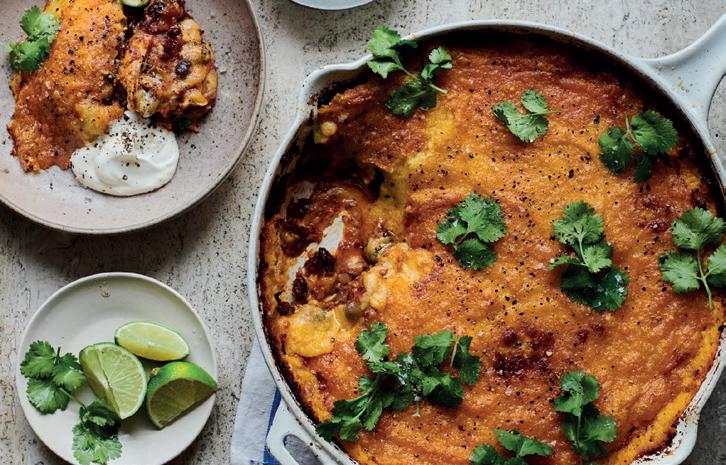
Our traders are here to provide the seasonal ingredients. The amazing chefs and food writers who find inspiration at the Market can help you decide what to do with them. Search now at